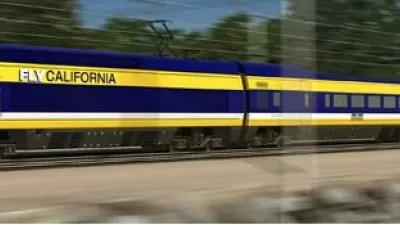Opposition, followed by legal action to the California High-Speed Rail project began in Northern California, spread to the Central Valley, and now has hit southern California, particularly in the San Fernando Valley of Los Angeles County.
In a series of articles, Ralph Vartabedian and Soumya Karlamangla of the Los Angeles Times examine the growing opposition to the project, including 300 people attending a June 9 High-Speed Rail Authority meeting in downtown Los Angeles. "Rail board chairman Dan Richard said the meeting was the biggest protest he could recall during his tenure."
As the detailed planning process begins to shift to Southern California, community leaders and neighborhood groups are launching challenges to a segment that would run between Palmdale and Burbank.
The meeting "followed the release of a key report that analyzed the effects of four different routes," they write. "The 62-page analysis shows that within half a mile of the track from Palmdale to Burbank, there could be noise and vibration affecting about 20,000 residences, 25 parks, 47 schools, 48 churches and nine hotels, as well as archaeological sites and wetlands."
Unlike opposition from three affluent, predominantly white communities on the San Francisco Peninsula, "several low-income and predominantly minority communities, including San Fernando, Pacoima and Sylmar, complained that their neighborhoods would be divided by 20-foot-high sound walls along the high-speed train corridor. Some said their areas had been already been chopped up by three major freeways and a dozen dumps."
In a related article, Vartabedian and Karlamangla write that "a coalition of communities is demanding that only routes that are predominantly underground should be considered."
The growing resistance is coming in part from urban, working-class neighborhoods that are portraying the surface route as an environmental injustice. Notably, those communities are longtime supporters of state Democrats who championed the project."
Vartabedian and Karlamangla detail the four routes. "It wasn't immediately clear how the outpouring of opposition might affect decisions about a route, which could take two years of environmental research and planning to complete."
FULL STORY: Bullet train runs into rising opposition over Southern California routes

Alabama: Trump Terminates Settlements for Black Communities Harmed By Raw Sewage
Trump deemed the landmark civil rights agreement “illegal DEI and environmental justice policy.”

Study: Maui’s Plan to Convert Vacation Rentals to Long-Term Housing Could Cause Nearly $1 Billion Economic Loss
The plan would reduce visitor accommodation by 25% resulting in 1,900 jobs lost.

Planetizen Federal Action Tracker
A weekly monitor of how Trump’s orders and actions are impacting planners and planning in America.

Wind Energy on the Rise Despite Federal Policy Reversal
The Trump administration is revoking federal support for renewable energy, but demand for new projects continues unabated.

Passengers Flock to Caltrain After Electrification
The new electric trains are running faster and more reliably, leading to strong ridership growth on the Bay Area rail system.

Texas Churches Rally Behind ‘Yes in God’s Back Yard’ Legislation
Religious leaders want the state to reduce zoning regulations to streamline leasing church-owned land to housing developers.
Urban Design for Planners 1: Software Tools
This six-course series explores essential urban design concepts using open source software and equips planners with the tools they need to participate fully in the urban design process.
Planning for Universal Design
Learn the tools for implementing Universal Design in planning regulations.
Caltrans
Smith Gee Studio
Institute for Housing and Urban Development Studies (IHS)
City of Grandview
Harvard GSD Executive Education
Toledo-Lucas County Plan Commissions
Salt Lake City
NYU Wagner Graduate School of Public Service




























